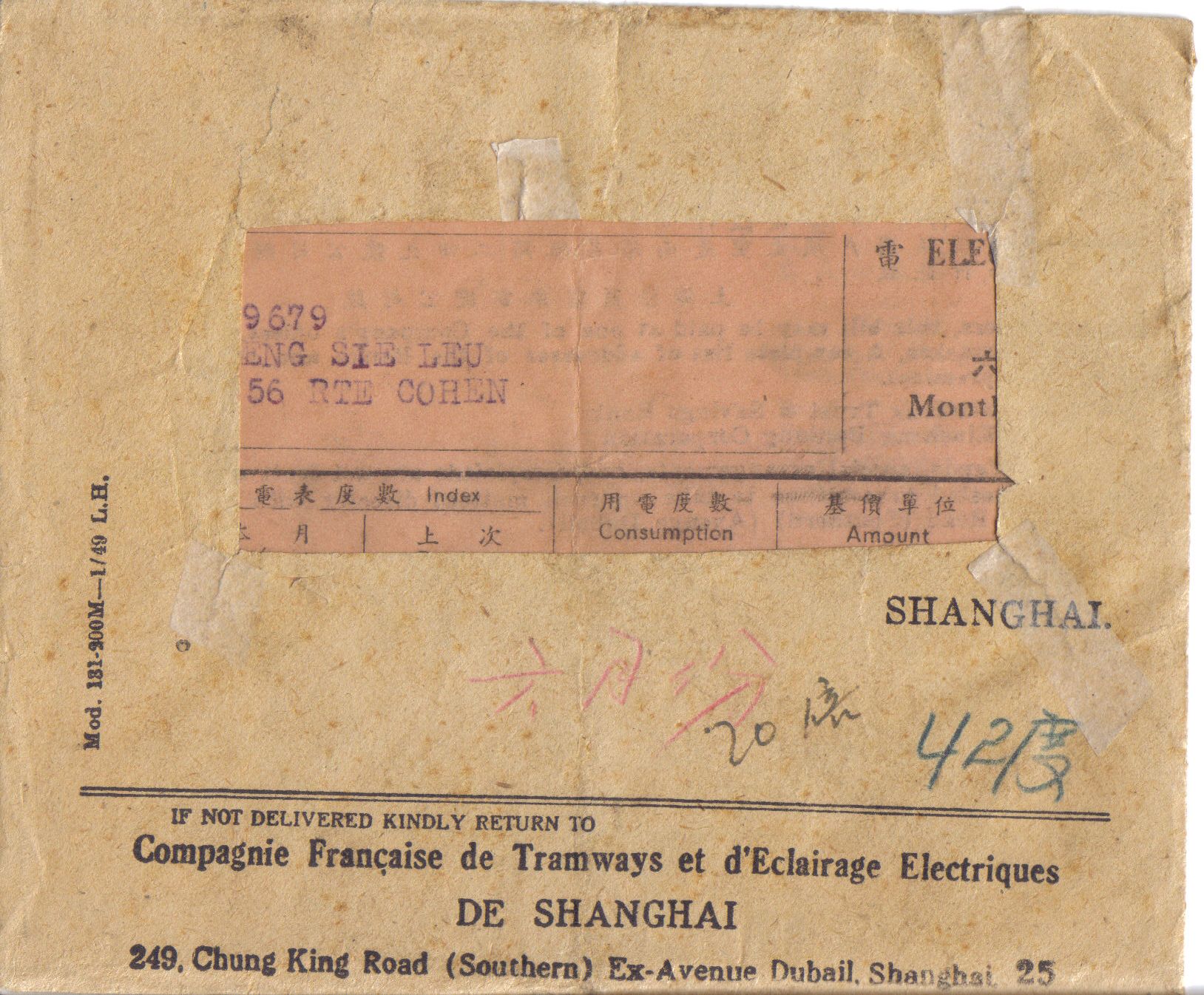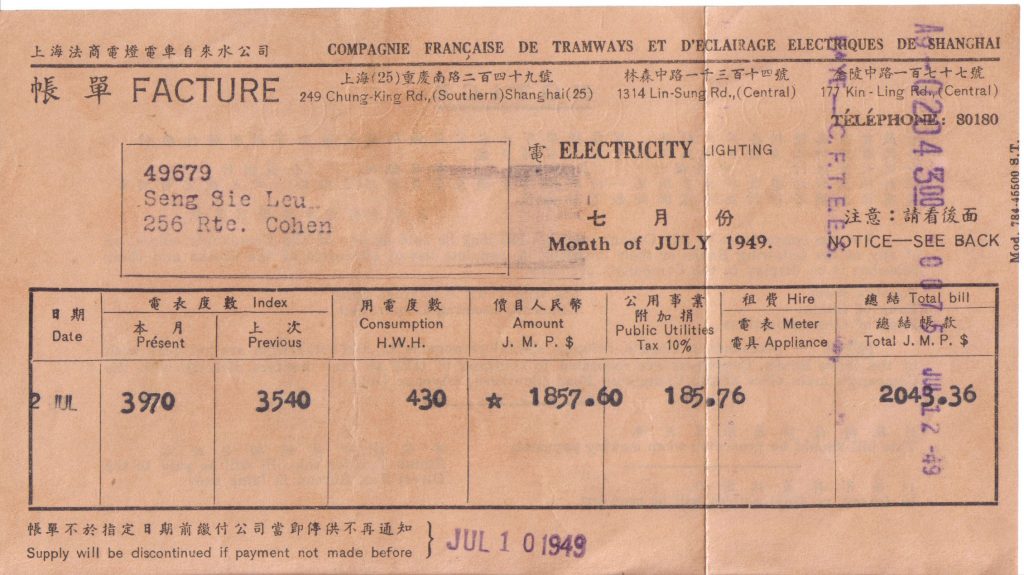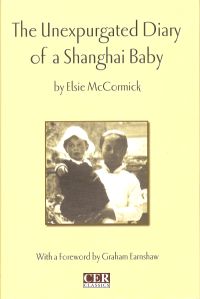 I still don’t understand how come I did not see this book in Shanghai… but bought it in Beijing instead. “The Unexpurgated Diary of a Shanghai Baby” is captioned by Graham Earnshaw as his “favorite book on old Shanghai by a long margin”. I knew the name of Graham Earnshaw throught Tales of Old Shanghai website, but I had not heard about the book before. After flipping through the pages for a minute, I bought on the spot and read it over in the train from North Korea.
I still don’t understand how come I did not see this book in Shanghai… but bought it in Beijing instead. “The Unexpurgated Diary of a Shanghai Baby” is captioned by Graham Earnshaw as his “favorite book on old Shanghai by a long margin”. I knew the name of Graham Earnshaw throught Tales of Old Shanghai website, but I had not heard about the book before. After flipping through the pages for a minute, I bought on the spot and read it over in the train from North Korea.
The book is the mock diary of a one year old baby living with his parents in HongKou district. First published in 1924, it’s a first hand witness of the life of the Shanghailanders. It is a lot of fun to read about the live of the father going to play golf and spending hours drinking at the club or at the race course. Dady probably works to support the family, but little mention is made of it in the book. Mummy’s main occupation is to give away the baby to the Amah (as Ayi were called then) and take care of her appearance. Staying with the family, Auntie (surely Mama’s younger sister) is going out with a boy or another, but does not seem to have a lot of brain. As all the nearby places the baby goes to are located in HongKou district, mainly “HongKew park” (today’s LuShun Gong Yuan), I guess the family lived in an appartment on Sichuan Bei Lu or the neighboring streets not far from the Suzhou creek.
Like a number of today’s expatriates in Shanghai, the kid is mainly raised by the Chinese Amah, giving us a great view of the life of the chinese domestics in foreign houses. The story of the houseboy stealing socks from the master, or using the lady’s fine garments and toiletries for cleaning purposes are hillarious… and not so far from stories I have heard in today’s Shanghai. The Chinese servants run every practical aspects of the house with the foreign owners having little control or understanding of it. This is also not so different from today’s foreigners’ life in Shanghai.
The writing is easy to read and very humorous, with Elsie Mc Cormick making fun of foreign life in Shanghai. It is a great introduction to old Shanghai, but also contains many details of the period that make in an invaluable resource for research on this topic. The writer went back to the US in the 1930’s and started to write for the New Yorker later on. As a proof of a writer’s quality, you hardly can get better.
Category: Uncategorized
Allez les Belges!
 The 2008 Olympic games mainly take place in Beijing, but a small bit is happening is other cities. Of course, all finals and prestigious events will be in Beijing, but other cities got some leftovers. Shanghai was generously granted the right to host a few qualifier football game. It was very difficult to get tickets for Olympic events, and only few people I know actually flew to Beijing to attend. Since we got tickets for a game taking place in Shanghai, two metro stops away from home, we decided to give it a go.
The 2008 Olympic games mainly take place in Beijing, but a small bit is happening is other cities. Of course, all finals and prestigious events will be in Beijing, but other cities got some leftovers. Shanghai was generously granted the right to host a few qualifier football game. It was very difficult to get tickets for Olympic events, and only few people I know actually flew to Beijing to attend. Since we got tickets for a game taking place in Shanghai, two metro stops away from home, we decided to give it a go.
The football game was Belgium – New Zealand, and the Belgium Consulate in Shanghai organized a gathering of Belgian people to support their team. Since the French team was not qualified for the tournament, I became a temporary supporter of the team of our friendly neighbors. The game was fun to watch in this crowd of Belgian expatriates who seem to get back some unity far away from the homeland. The French speaking people were shouting “Allez la Belgique”, the Flemish speaking shouting “Belgie” and the consensus ended up with “Belgium, Belgium” the country name in English (different from the one in French or in Flemish, being sort of a neutral ground). I even heard a few (Bilishe Jia You” Go Belgium” in Chinese). It was a nice evening followed by a few beers in local bar. Taking part (even a small one) in a world event like the Olympic was fun. Final score: Belgium 1, New Zealand 0.

First Russian Bakery & Tkachenko
Writing the last post about Paul bakery attracted my attention to bakeries in the old Shanghai. There was a lot of foreigners but not that many French (probably about 1200 in the French concession at most). Still, from the documents I read and knowledge about European culture, there must have been bakeries in Shanghai to satisfy foreign (and Chinese appetites). The best place to look was surely my 1938 version of the Shanghai Dollar diary (more about it in an upcoming post).
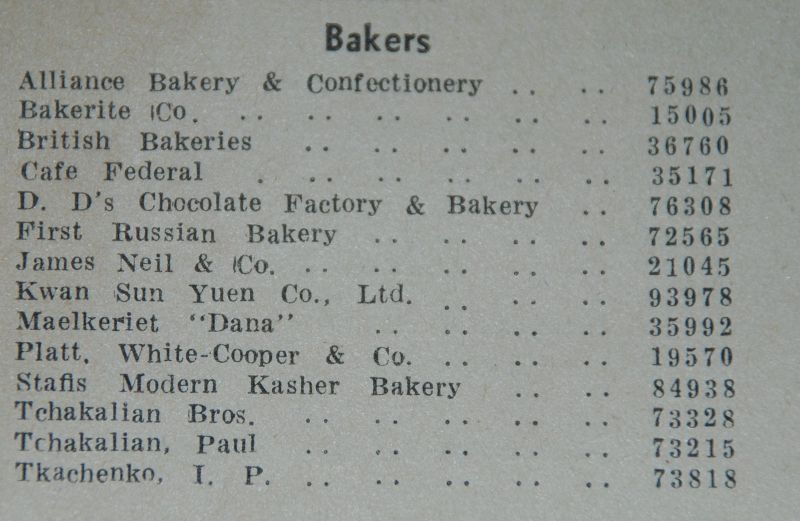 I looked into the “bakery” entry of this older version of the phone book and found out 15 entries. I remember reading that the bakery business in the 30’s was run by many Russians in Shanghai. By looking at the names of the shop, at least 5 of them were run by Russians. The most obvious was First Russian bakery, Tchakalian (more about in a further post) and Tkachenko.
I looked into the “bakery” entry of this older version of the phone book and found out 15 entries. I remember reading that the bakery business in the 30’s was run by many Russians in Shanghai. By looking at the names of the shop, at least 5 of them were run by Russians. The most obvious was First Russian bakery, Tchakalian (more about in a further post) and Tkachenko.
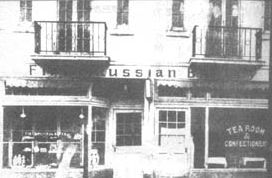 First Russian bakery is pictured right (picture is from the website of the Shanghai municipal archives). Located on 234-
First Russian bakery is pictured right (picture is from the website of the Shanghai municipal archives). Located on 234-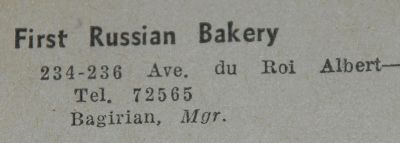 236 Avenue du Roi Albert (This now Shanxi Nan Lu, the location was approximately opposite Parkson on the other side of Shanxi Nan Lu). This was the urban art of the French Concession where many small apartment buildings were built, not far from Cathay Apartments, Brooklyn Court and the Cercle Sportif Francais. I will have to check, but if the building still exist, it’s probably a cloths shop nowadays.
236 Avenue du Roi Albert (This now Shanxi Nan Lu, the location was approximately opposite Parkson on the other side of Shanxi Nan Lu). This was the urban art of the French Concession where many small apartment buildings were built, not far from Cathay Apartments, Brooklyn Court and the Cercle Sportif Francais. I will have to check, but if the building still exist, it’s probably a cloths shop nowadays.
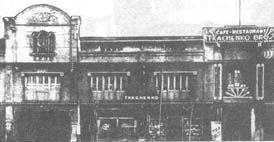 Tkachenko bakery was also pictured on the same website.
Tkachenko bakery was also pictured on the same website.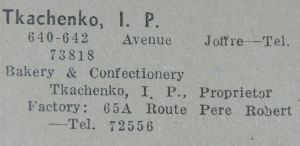
As you can see, they were located in a large mansion of early Shanghai style. This is surely a much earlier building than the one of First Russian Bakery, but it was located only about 15 minutes walk away from it. 640-642 Avenue Joffre is today HuaiZhong lu, north side about half way between Yan Dang Lu and Sinan Lu. It’s approximately opposite the current Sephora shop. The original building was torn down since, probably in the 1990’s. This Avenue Joffre location was a bakery but also a Cafe and Restaurant (as seen on the picture). it would have been the ideal place to stop after shopping on Avenue Joffre (just like Paul today). It was typical of this part of the French Concession that attracted a lot of the White Russians and took the nickname of little Russia. Tkachenko also had factory and confectionery on Nearby Route des Soeurs (today RuiJin Er Lu), just after the corner with Nanchang lu.
This setup of having a shop on a prime location with a factory and confectionery in different location is very similar to today’s Visage chocolate shop and bakery (with its shop in XianTianDi and bakery and confectionery at the cross of HongQiao Lu and HuaiHai lu). The nearest thing to today’s Paul was probably the Tchakalian bakery, but this will the topic on another post.
Unpaid bills
In a recent trip to an antic market, I ran into a large stack of old papers. They were sketches and drawing from an unknown artist. I was not really interested… but my friend was. He looked at all the drawings one by one, spending so much time with them that I was already moving a few vendors down the line. He called me back and pointed out to these three envelops that he found but had no idea what they were. One of them is the picture below.
“Compagnie Francaise de Tramways et d’Eclairage Electrique de Shanghai” (CFTEE), i.e. Tranmways and Electric Lighting company of Shanghai, was written on the envelop. The largest employer of the French Concession, “La Compagnie” as it was often called, was the main utility company of the concession, producing and delivering electricity, supplying running water and operating tramway lines (see post “Old Shanghai Tramways” for more details), as well as bus lines (see post “Old Shanghai full bus schedule 1931” for more details). One of the managers was Mr Lubeck (See post “The story of the Lubeck family and their house in Shanghai” for more details).
These three little envelops, contained three electricity bills from May, June and July 1949. As China was liberated by the communist party in October 1949, they were among the very last ones to be sent by the company under the nationalist regime. The company was later nationalized and surely part of today’s electricity company.
The bills themselves are in English and Chinese, with no French writing except being called “Facture” and the phone number indicated as “téléphone”. Just seeing the name of the company written in French is like a living proof of the very existence of the French concession. Details and daily life objects like this make history become so much more real.
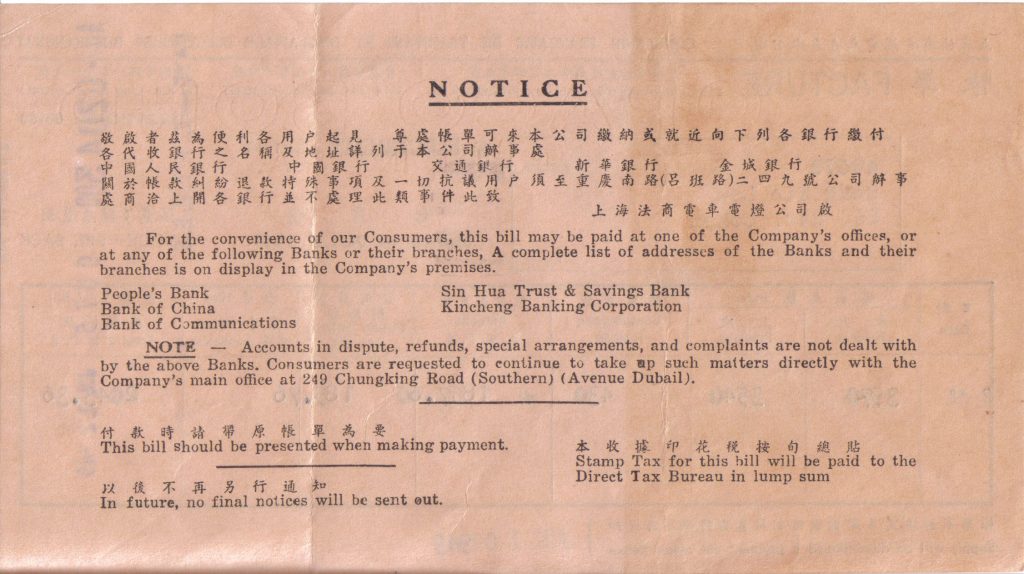
The electricity company address was noted as 249 Chung-King Road (Southern), that is formerly Avenue Dubail. Street names have been changed several times in Shanghai, including in 1945 after concessions were given back to China. The whole former Avenue Dubail has been destroyed in the 90’s to build the famous flyover motorways of Shanghai, but the original office is still there. The address where it was sent to, “Seng Sie Leu, 256 Route Cohen” (now Gaoan Lu) is very near from my street, Route Kaufmann (now Anting Lu). It would be funny seeing the face of the house owner, being shown those unpaid bills from 60 years ago. This is only daydreaming, as the receiver of these electricity bills has probably been chased out of their house long ago.
In any case, after a second look I realized that the bills have actually been settled in July 1949. No chance of collecting any money from these old bills, but just looking at them is still fascinating.
More info about the CFTEE are available on post “French companies in 1920s and 1930s Shanghai“. For information about the tram network of the CFTEE, see post “Old Shanghai tramways“.
Shanghailander articles are published on an irregular basis. To be notified when a new article is posted, subscribe to the newsletter using this link, or follow the Shanghailander Facebook page.
Opening post
It’s a warm night in Shanghai, and after discussing it many times with friends, I am starting this blog. There are already many blogs about Shanghai or about the experience of foreigners in China. I will try to add my little original touch to this electronic mess. This blog is dedicated to Shanghai both old and new.
By “Old Shanghai”, most people understand Shanghai during colonial times, i.e. from the settlement of Shanghai (1842) before the “liberation” of China by the communist party (1st October 1949).
By “New Shanghai”, I mean the change of the city from sleeping beauty until the opening fast development of the city from the early/mid nineties.
This also includes present times, as Shanghai is still a city in rapid transformation both in its appearance and socially. My fascination and love are for both periods in a different ways, this is why I have tried to share this double passion in the same blog. I hope you will enjoy reading this blog, as much I enjoy living here.
